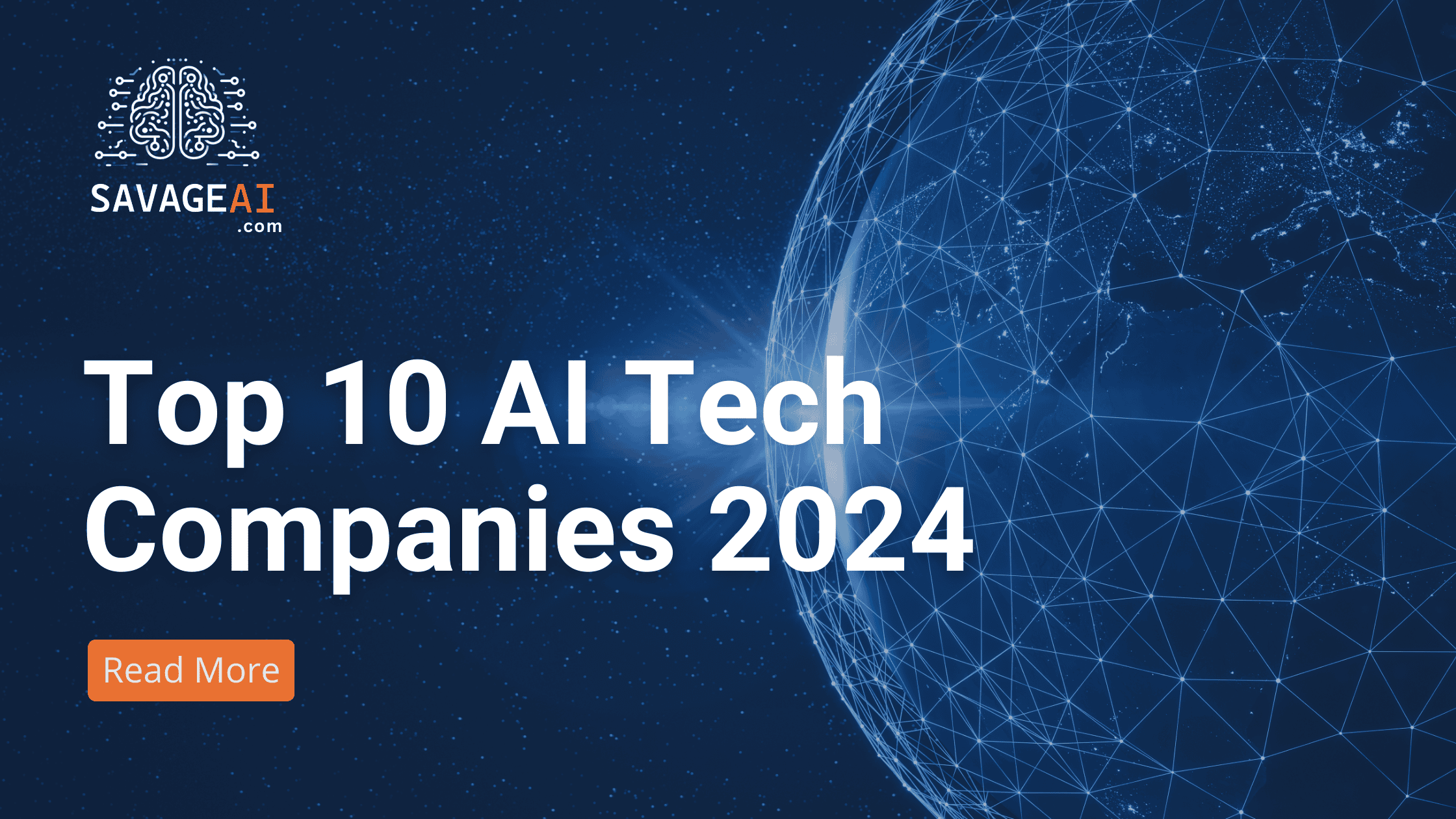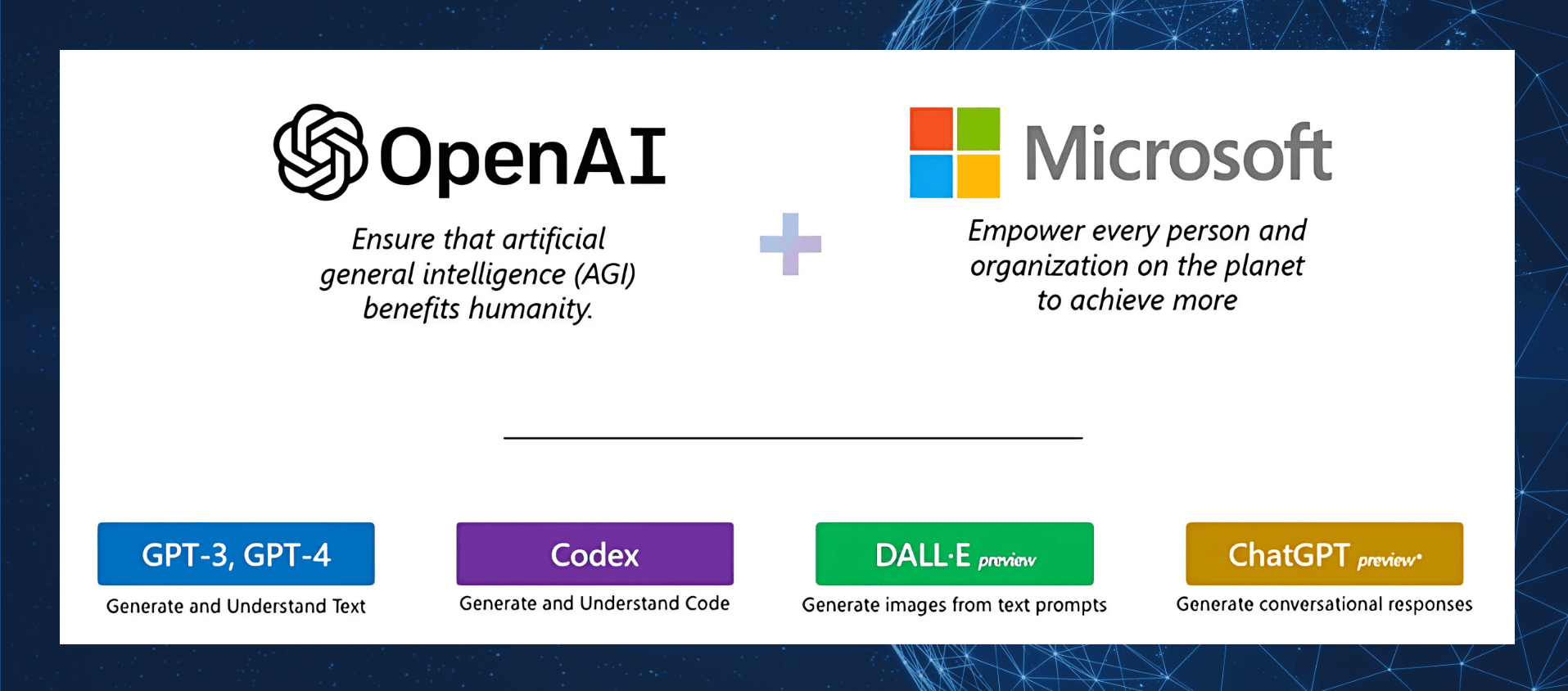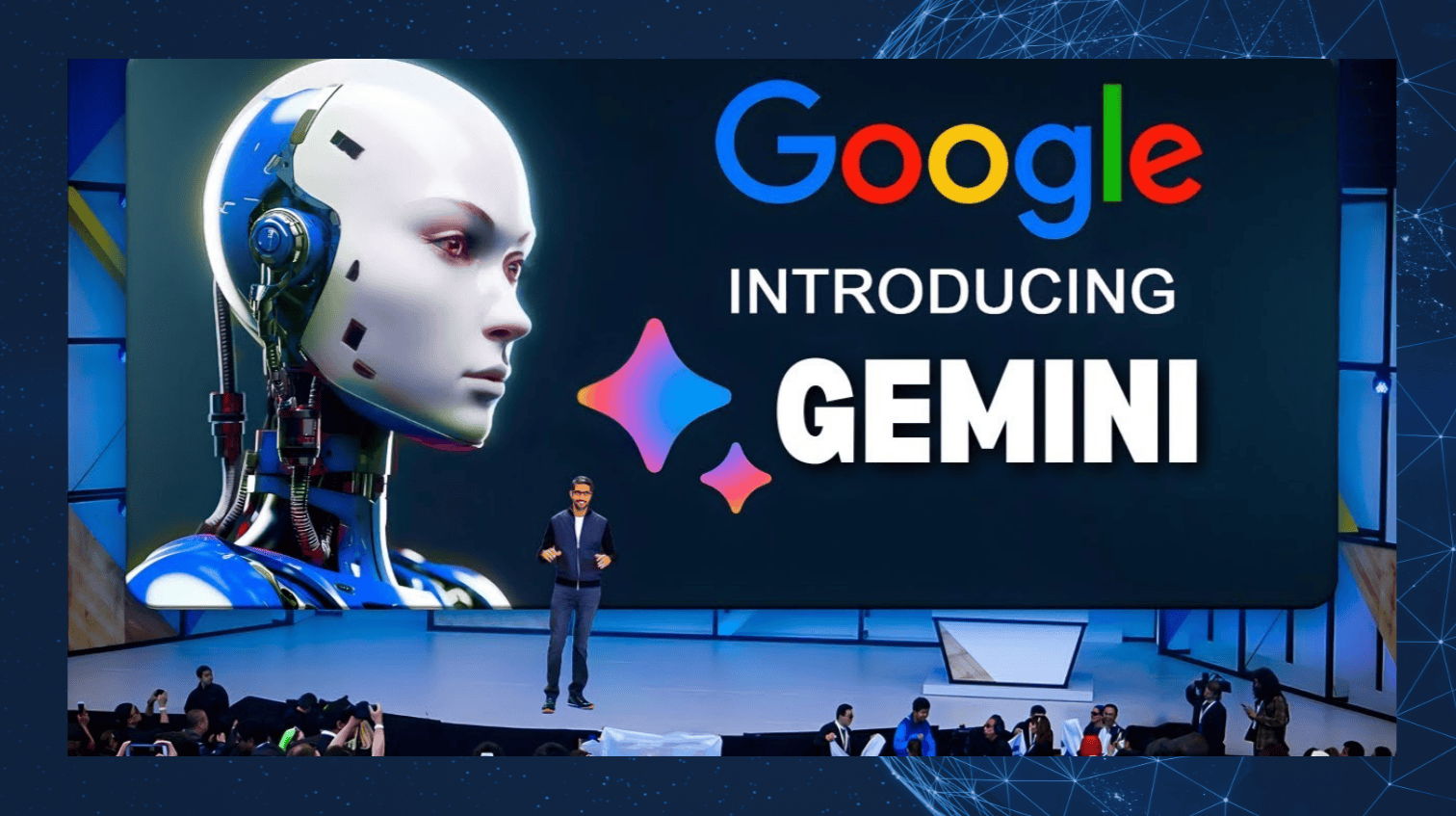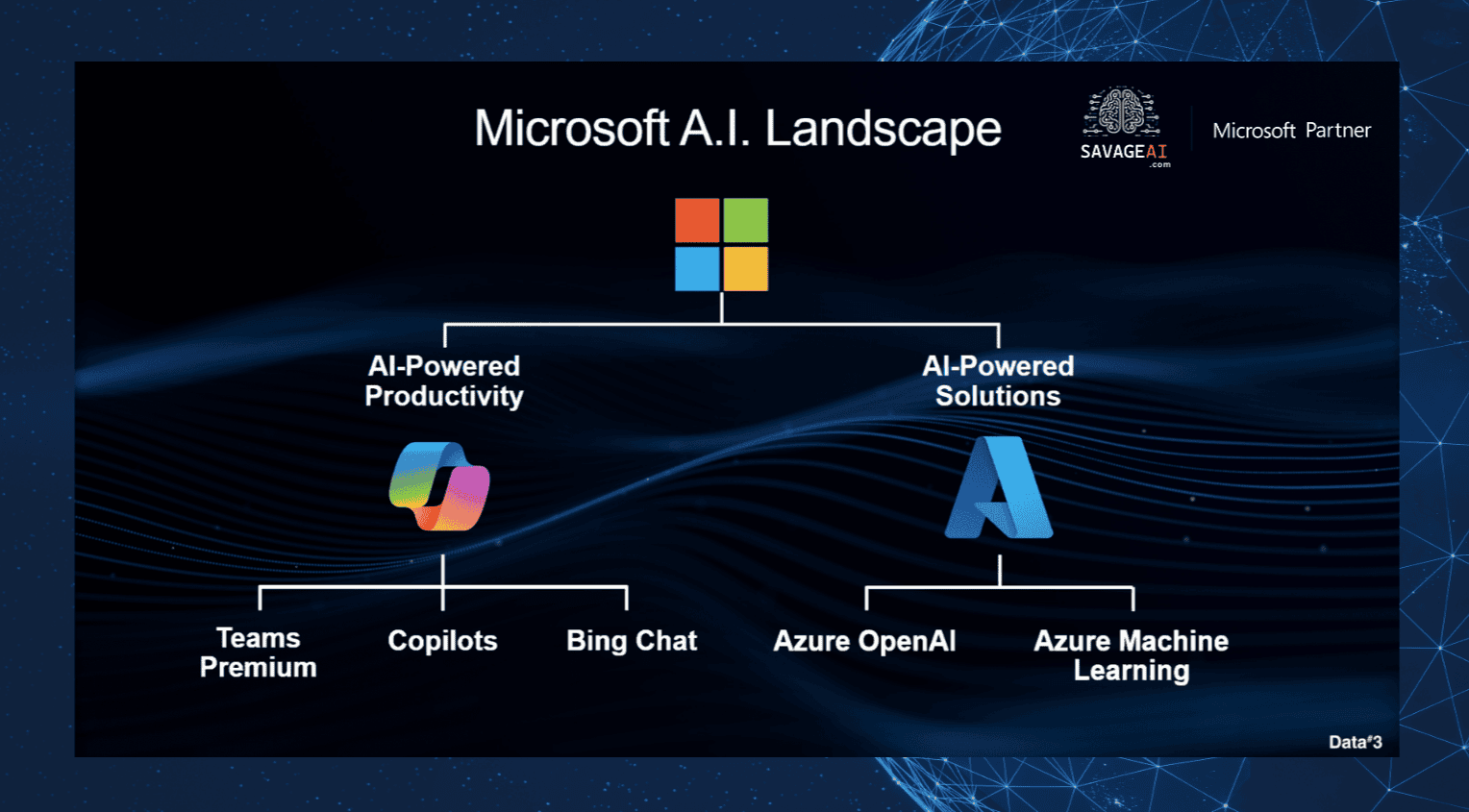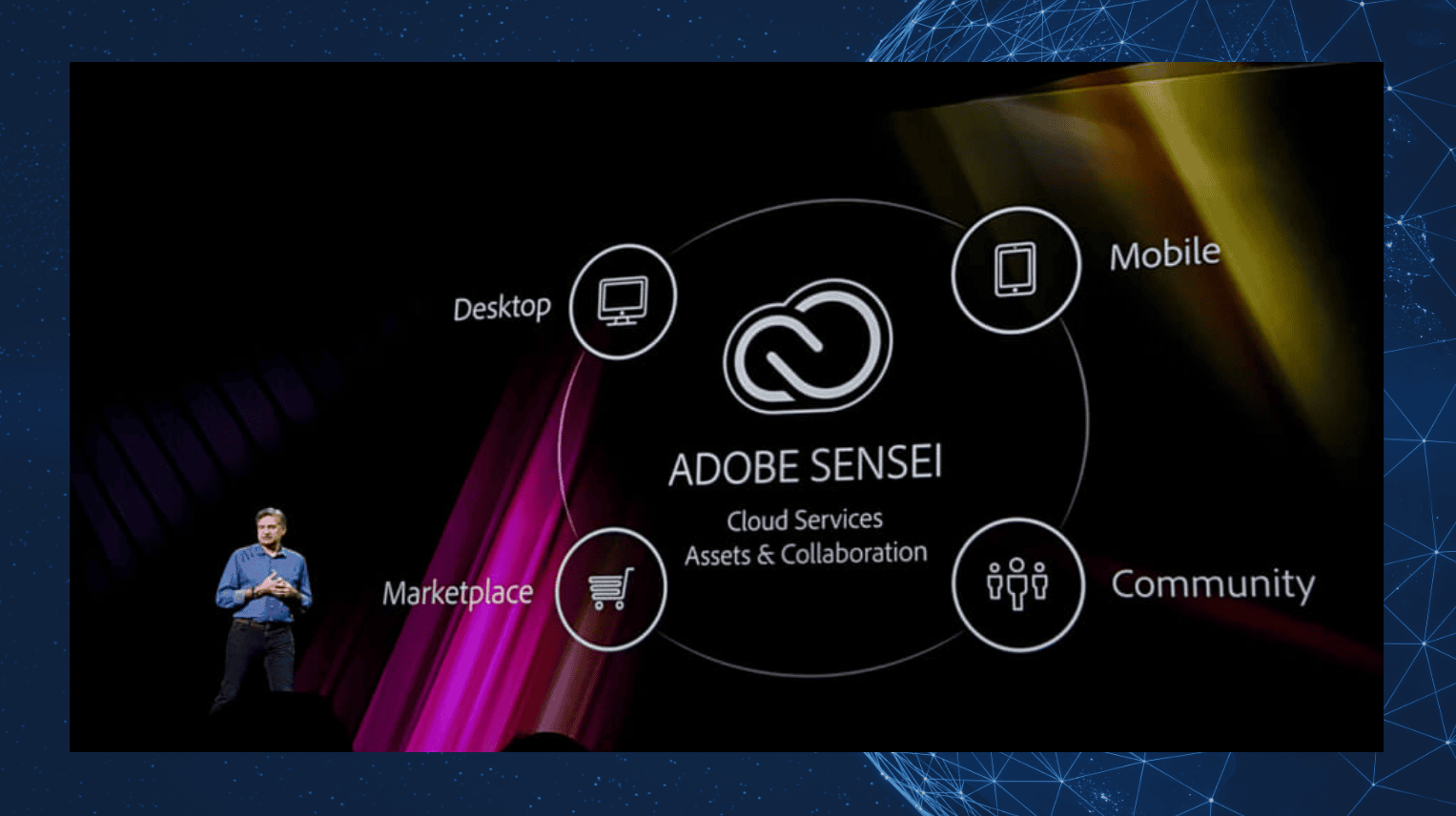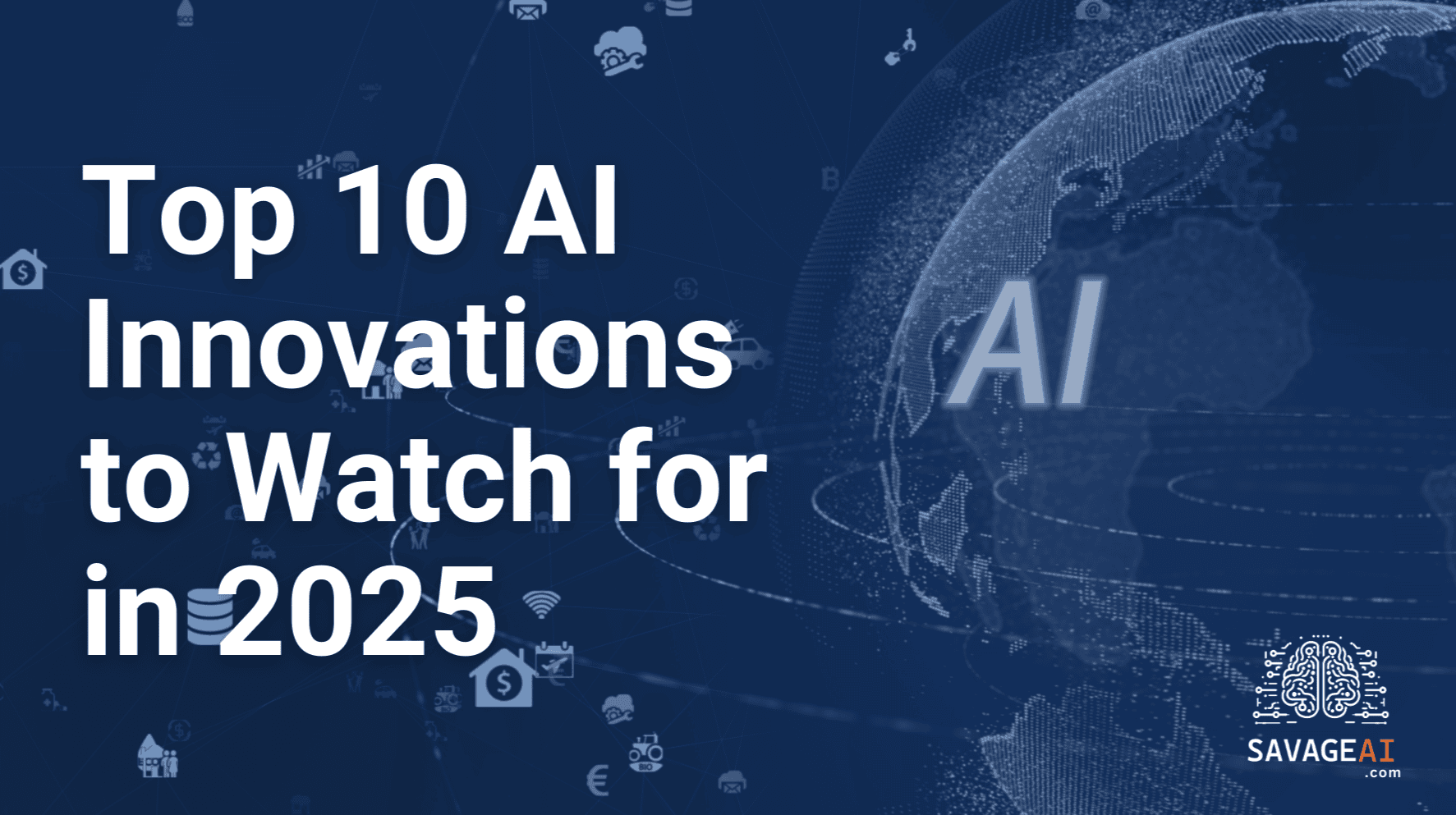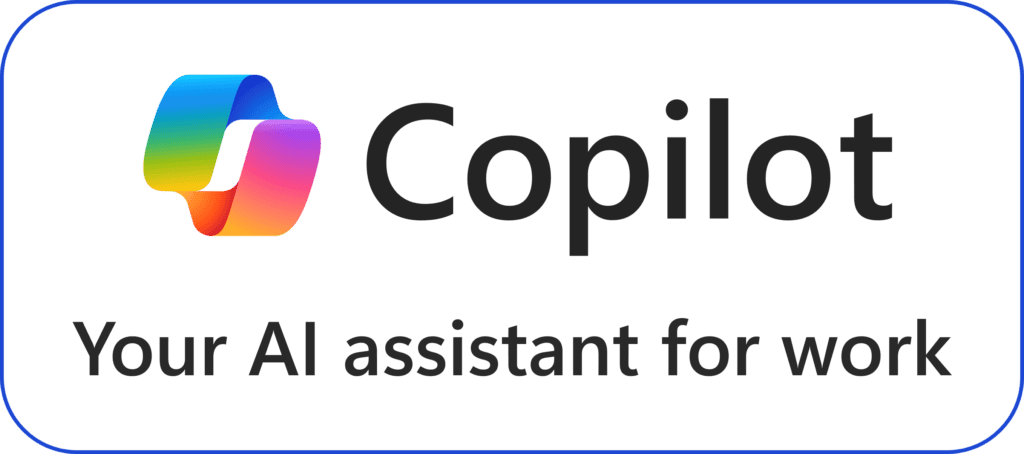Be in the know with SAVAGE AI News & Free Articles!
Your source for AI news and training options for your team!
Welcome to your ultimate source for cutting-edge AI news and insights! Dive into the world of Microsoft AI, where you’ll discover the latest advancements in Azure and Copilot. Stay informed about groundbreaking technologies like ChatGPT, Google Gemini, Apple Intelligence, and Meta AI. From Healthcare to Finance, Manufacturing to Customer Service, we are committed to finding and explaining the tools that are reshaping industries.
Join us as we navigate the future of artificial intelligence and its profound influence on our world and how we get work done. We will also focus on skills training that helps individuals, businesses, and organizations make practical use of these tools in a responsible way.
-
✴︎
Top 10 AI Tech Companies of 2024
As the CEO of a company dedicated to educating professionals on maximizing the potential of AI, I can offer a unique and unbiased perspective on the industry’s landscape. I’ve observed numerous outstanding companies and their significant impact on businesses worldwide. With this expertise, I am excited to share my insights on the top 10 AI tech companies of 2024, along with other notable trends and predictions for 2025.
When it comes to Artificial intelligence (AI), 2024 is sure to go down in history as another pivotal year. Industry after industry continues to revolutionize products, services, and drive economic growth with new AI tools. And with AI adoption on the rise (72% of organizations now use AI in at least one business function according to McKinsey & Company, and PwC projects a 21% net increase in U.S. GDP by 2030 due to AI advancements) the following companies are at the forefront of innovation. Here, I rank the top AI tech companies, breaking down why they stand out, their industry impact, their practical use cases, along with a justification for our ranking.
Table of Contents
1. OpenAI (ChatGPT, Codex, and DALL-E)
Why it stands out:
OpenAI has spearheaded generative AI innovation with models like GPT-4o and DALL·E, pushing the boundaries of natural language processing (NLP) and image generation since it released ChatGPT in November 2022.
Industry impact:
Its technologies power conversational AI, content creation, and education, and is being used across industries. Its wide use has introduced a problem for many businesses known as “shadow AI”, or the practice of employees using tools like ChatGPT on the job even though they are not permitted.
Use cases:
- ChatGPT continues to enhance customer service, assist in content creation, research, education, and personal assistant tasks, making it a versatile tool for everyone. And with the release of 4o in May, the product was further enhanced with voice and vision capabilities.
- DALL·E generates unique images from textual descriptions, making it a powerful tool for graphic design, marketing, product design, and entertainment. It creates custom visuals for various applications, inspiring new artistic creations and enhancing visual storytelling.
- Codex assists developers by generating code snippets, debugging, and explaining code functionality. It helps with writing and refactoring code, automating repetitive tasks, and improving coding efficiency, making it a valuable resource for programmers of all levels.
Ranking justification:
OpenAI’s groundbreaking research and transformative products have set industry standards, securing its leadership position. It has remained the most well-known and favorite for most individuals, both personally and professionally.
2. NVIDIA
Why it stands out:
NVIDIA’s GPUs (Graphical Processing Units) power AI development and enable deep learning breakthroughs across industries. Their hardware and software ecosystems support researchers and enterprises globally, making them a driving force in AI technology.
Industry impact:
NVIDIA’s contributions are foundational to the field of AI. Their GPUs are essential for training AI models, running AI applications, and powering many of today’s leading AI innovations. NVIDIA’s hardware and software solutions are used in various sectors, including healthcare, automotive, and finance, to accelerate AI research and deployment.
Use cases:
- Cloud services: NVIDIA’s GPUs power many cloud services, providing the computational power needed for AI workloads. This includes services like Amazon Web Services (AWS) and Google Cloud, which rely on NVIDIA’s technology to deliver scalable AI solutions1.
- Autonomous vehicles: NVIDIA’s AI technology is used in autonomous vehicles to enable self-driving capabilities. Their DRIVE platform provides the hardware and software needed for autonomous driving, making transportation safer and more efficient1.
- AI-powered simulations: NVIDIA’s GPUs are used in AI-powered simulations for various applications, including scientific research, engineering, and entertainment. These simulations help researchers and developers create more accurate models and predictions1.
- Large-scale data analysis: NVIDIA’s technology enables large-scale data analysis, allowing businesses to process and analyze vast amounts of data quickly and efficiently. This is crucial for industries like finance and healthcare, where data-driven insights are essential1.
- Generative AI: NVIDIA’s tools, such as Chat with RTX and AI Workbench, enable developers to create and customize AI applications. These tools support tasks like generating custom images, fine-tuning language models, and building AI chatbots
Ranking justification:
As the backbone of AI infrastructure, NVIDIA’s contributions are foundational to the field. Its central role in enabling nearly all AI advancements positions it among the top innovators. While NVIDIA provides robust tools for AI deployment, it lacks the same level of notoriety that OpenAI currently enjoys from ChatGPT.
3. Google (DeepMind, Gemini, AI Studio, Waymo, TensorFlow)
Why it stands out:
Google’s AI services, including DeepMind, Gemini, AI Studio, Waymo, and TensorFlow, are at the forefront of AI innovation. These services leverage advanced machine learning and neural network technologies to push the boundaries of what’s possible in AI. From groundbreaking research in reinforcement learning and protein folding to developing versatile multimodal models and autonomous driving technology, Google’s AI initiatives are setting new standards in the industry.
Industry impact:
These technologies are transforming various sectors, including healthcare, transportation, content creation, and software development. DeepMind’s AlphaFold is revolutionizing biological research and drug discovery, while Waymo’s autonomous driving technology is poised to change the future of transportation. TensorFlow’s open-source framework supports a wide range of AI applications, fostering innovation across industries. The integration of these AI services into everyday applications is driving digital transformation and enhancing efficiency and safety.
Use cases:
- DeepMind is known for its achievements like AlphaGo and AlphaFold, DeepMind’s AI technologies are used in healthcare to diagnose diseases and predict patient outcomes, and in scientific research to understand protein structures, aiding in drug discovery and biological research.
- Gemini is a family of multimodal AI models excels in generating and understanding text, images, audio, and video. Gemini is used in content creation for marketing and entertainment, enhancing customer service with more natural interactions, and providing personalized educational content.
- AI Studio simplifies the development and integration of AI models, making it easier for developers to build AI-powered applications. It supports application development, API integration, and prompt development, enabling businesses to leverage advanced AI capabilities.
- Waymo is an autonomous driving technology is used in self-driving taxi services, logistics, and delivery, improving transportation safety and efficiency. Its extensive real-world testing and deployment are paving the way for the future of urban mobility.
- TensorFlow is a versatile machine learning framework used for developing and deploying AI models. It supports research and production applications, enabling model development, deployment on various platforms, and facilitating cutting-edge AI research.
Ranking justification:
Google’s extensive integration of AI into daily services solidifies its influence and reach. However, Google ranks below OpenAI and NVIDIA due to its broader focus on multiple AI applications rather than pioneering a single groundbreaking innovation
4. Microsoft (Copilot and Azure AI)
Why it stands out:
With over 80% of fortune 500 companies already using Microsoft, that have integrated AI tools into their existing Office productivity suite and enterprise solutions that most businesses already use daily. As such, Microsoft excels in business analytics, AI-powered office applications, and intelligent cloud solutions. Their seamless integration of AI into widely-used tools makes them a standout in the industry.
Industry impact:
Microsoft released Copilot in November 2022 and have been enhancing it throughout 2024. From enterprise tools like Power BI to conversational AI through Copilot, Microsoft excels in normalizing AI for productivity. As companies become aware of these tools ready to deploy securely inside their existing systems, they will continue to rapidly adopt them. Microsoft’s AI integration is transforming how businesses operate, making advanced analytics and automation accessible to a broader range of users. This democratization of AI tools is driving efficiency and innovation across industries.
Use cases:
- Copilots are already integrated into Word, Excel, PowerPoint, Outlook, and Teams, enhancing productivity inside each app. And as a chat agent, Copilot is just as powerful as ChatGPT and Gemini. One could even make a case that it is more powerful because it securely has access to the data in your Microsoft account, creating a unique and more informed personal AI assistant for each user.
- Azure AI services provide comprehensive cloud-based solutions for businesses of all sizes to develop AI-enhanced custom applications based on their own data and existing systems. This includes document processing, image and video analysis, and custom chatbots informed by your company data. These tools open the door to more efficient business processes and enhanced customer service.
Ranking justification:
You’d think such integration and built-in security would earn Microsoft a higher ranking in our list; however, Copilot falls behind both ChatGPT and Gemini in adoption, placing it as number 4 in our book. Will Microsoft raise awareness of their products throughout 2025? As a company trusted by most businesses and professionals for over 30 years (think Windows 95), and still used daily, it is likely that as awareness grows, they may move up our list by the end of 2025.
5. Amazon (AWS AI)
Why it stands out:
Amazon leverages their popular cloud service, AWS (Amazon Web Services) to deliver scalable machine learning services for businesses. AWS AI provides a comprehensive suite of AI and machine learning services that cater to various industries and use cases, making it a versatile and powerful platform for AI development.
Industry impact:
AWS equalizes AI access for startups and enterprises through tools like SageMaker. SageMaker simplifies the process of building, training, and deploying machine learning models, enabling businesses of all sizes to harness the power of AI. AWS AI’s extensive range of services and tools ensures that companies can integrate AI into their operations seamlessly.
Use cases:
- Personalized shopping recommendations: AWS AI powers personalized shopping experiences by analyzing customer data to provide tailored product recommendations. This enhances customer satisfaction and drives sales.
- Supply chain optimization: AWS AI helps businesses optimize their supply chains by predicting demand, managing inventory, and improving logistics. This leads to cost savings and increased efficiency.
- Cloud-based AI tools: AWS AI offers a variety of cloud-based tools that enable businesses to develop and deploy AI applications quickly and efficiently. These tools include natural language processing, computer vision, and automated machine learning services.
- Conversational AI: AWS AI provides services for building chatbots and virtual assistants that can handle customer inquiries, automate responses, and improve customer service.
- Fraud detection: AWS AI helps businesses detect and prevent fraud by analyzing transaction data and identifying suspicious patterns.
- Healthcare diagnostics: AWS AI supports healthcare providers by enabling the development of AI models that can assist in diagnosing diseases and predicting patient outcomes.
Ranking justification:
While AWS’s dominance in cloud computing is undisputed, when it comes to AI, it did not beat out OpenAI, NVIDIA, Google, or Microsoft due to its primary focus on cloud computing rather than pioneering AI research and development. While AWS provides robust tools for AI deployment, it lacks the same level of groundbreaking innovations and specialized AI applications that the top-ranked companies offer.
6. IBM (Watson)
Why it stands out:
IBM Watson specializes in AI for business and healthcare, emphasizing explainable AI and robust analytics. Watson’s AI capabilities are designed to provide insights and support decision-making processes across various industries.
Industry impact:
IBM Watson is transforming industries with tailored AI solutions, from fraud detection to medical diagnostics. Its AI-driven insights help businesses optimize operations and improve outcomes in healthcare, finance, and customer service.
Use cases:
- AI-driven chatbots enhance customer service by providing accurate and timely responses to customer inquiries.
- Predictive analytics for supply chains help businesses predict demand, manage inventory, and optimize supply chain operations.
- Advanced healthcare insights assist healthcare providers in diagnosing diseases, personalizing treatment plans, and predicting patient outcomes.
Ranking justification:
Watson’s enterprise focus and innovation in specialized AI applications ensure its relevance. It ranks below AWS due to its narrower focus and less widespread adoption.
7. Meta (formerly Facebook)
Why it stands out:
Meta focuses on AI advancements in social interaction, AR/VR, and content moderation. Technologies like PyTorch empower developers worldwide, while AI-driven moderation ensures safer online spaces.
Industry impact:
Meta’s AI technologies are transforming social media, virtual reality, and content moderation. PyTorch, an open-source machine learning library, is widely used by researchers and developers to build and deploy AI models.
Use cases:
Personalized Content on Facebook and Instagram by Meta’s AI algorithms analyze user behavior to deliver personalized content and advertisements.
Virtual Worlds in the Metaverse: The Metaverse is enhanced with AI to enable the creation of immersive virtual environments, enhancing user experiences and fostering deeper social interactions. AI-driven features such as realistic avatars, dynamic environments, and intelligent NPCs (non-player characters) make the virtual worlds more engaging and interactive.
Advanced Translation Tools: These tools facilitate communication across languages, making social interactions more inclusive.
Real-time Content Moderation: Meta uses PyTorch to develop advanced models for real-time image and video analysis to ensure safe and appropriate content on its platforms. These models can detect and flag inappropriate content, such as violence, nudity, or hate speech, with high accuracy and speed.
Ranking justification:
Meta’s vision for AI-driven social and immersive experiences keeps it a critical player. However, its focus on consumer-centric applications limits its broader enterprise influence.
8. Anthropic
Why it stands out:
Anthropic focuses on AI safety and interpretability, aiming to create AI systems that are reliable and beneficial. Their research emphasizes understanding and mitigating risks associated with advanced AI.
Industry impact:
Anthropic’s work is crucial in ensuring that AI technologies are developed responsibly. Their contributions to AI safety protocols and interpretability frameworks are widely recognized and adopted across the industry.
Use cases:
- AI safety research: Anthropic conducts cutting-edge research to identify and mitigate potential risks in AI systems, ensuring they operate safely and predictably.
- Interpretable AI models: They develop models that are easier to understand and trust, which is essential for applications in healthcare, finance, and other critical sectors.
- Ethical AI deployment: Anthropic collaborates with other organizations to promote ethical AI practices, influencing policy and regulatory frameworks.
Ranking justification:
Anthropic’s dedication to AI safety and ethical considerations places it among the top AI companies. Its focus on creating interpretable and reliable AI systems is increasingly important as AI technologies become more integrated into various aspects of society.
9. Adobe (Sensei)
Why it stands out:
Adobe Sensei integrates AI into creative workflows, enhancing productivity and creativity. It powers many of Adobe’s flagship products, providing AI-driven features that streamline creative processes.
Industry impact:
Adobe Sensei is revolutionizing digital marketing and design through AI-powered automation. Its tools help creatives produce high-quality content more efficiently and effectively.
Use cases:
- Automated video editing with Adobe Sensei’s AI capabilities assist in editing videos by automating repetitive tasks and suggesting improvements.
- Marketing analytics are provided by Adobe Sensei by analyzes marketing data to provide insights and optimize campaigns.
- Personalized design content can be generated via Adobe Sensei for users, enhancing engagement and user experience.
Ranking justification:
Adobe continues to lead in its niche, showcasing innovative AI integration within its robust suite of graphic design tools. Its ongoing transformative impact on creative industries secures its place in our top 10 list.
10. Hugging Face
Why it stands out:
Hugging Face democratizes NLP with its widely-used Transformers library. Its open-source tools make state-of-the-art AI accessible to developers and researchers.
Industry impact:
Hugging Face empowers developers to implement advanced NLP models with ease, fostering innovation in AI applications across industries. Its Transformers library is a go-to resource for building and deploying NLP models.
Use cases:
- Chatbots developed with Hugging Face’s NLP models create intelligent chatbots that can understand and respond to user queries.
- Sentiment analysis can be used to analyze customer sentiment and gain insights into customer opinions. Machine translation using Hugging Face’s models facilitates accurate and efficient translation between languages.
- Machine translation using Hugging Face’s models facilitates accurate and efficient translation between languages.
Ranking justification:
Hugging Face’s open-source tools make AI innovation accessible to all, securing its position on our list. However, concerns about open-source security often limit its adoption in enterprise environments. Additionally, unless something truly innovative emerges, many of its use cases and features seem to replicate those of commercial products. Nonetheless, the importance of open-source to the community at large makes Hugging Face’s contributions significant and commendable.
Major AI Accomplishments of 2024
2024 witnessed groundbreaking advancements in artificial intelligence, solidifying its transformative potential across industries. Some of the year’s most notable achievements include:
- OpenAI’s GPT-4 Enhancements: OpenAI released significant updates to GPT-4, improving contextual understanding and reasoning capabilities. This led to broader adoption across education, healthcare, and enterprise communication.
- NVIDIA’s Breakthrough in Generative AI Hardware: NVIDIA unveiled the H100 Tensor Core GPU, specifically engineered to accelerate generative AI models. This hardware innovation has become the backbone for training advanced AI applications.
- Google DeepMind’s AlphaDev: DeepMind introduced AlphaDev, an AI designed for software optimization, demonstrating its ability to write more efficient code than human developers.
- Microsoft’s Integration of Copilot: Microsoft introduced Copilot across its Office suite, blending AI-driven productivity tools into daily workflows for millions of users.
- Amazon AWS AI’s Expansion: AWS expanded its AI capabilities with advanced machine learning services, making AI accessible for startups and enterprises alike.
- IBM Watson’s Oncology AI: IBM Watson demonstrated success in deploying AI solutions for personalized cancer treatment plans, integrating genomics and medical history for precise recommendations.
- Meta’s AI in the Metaverse: Meta achieved new milestones in real-time rendering and interaction, making the Metaverse more immersive and accessible.
- Anthropic’s AI Safety Research: Anthropic made significant strides in AI safety and interpretability, developing frameworks and protocols to ensure AI systems operate reliably and ethically. Their work has been instrumental in promoting responsible AI development across the industry.
- Adobe Sensei’s Creative Breakthroughs: Adobe introduced real-time generative design features in Photoshop and Premiere Pro, revolutionizing content creation workflows.
- Hugging Face’s Open Source Expansion: Hugging Face significantly expanded its open-source library, enabling enterprises and startups alike to harness advanced NLP capabilities.
These accomplishments showcase how AI continues to break barriers, from enhancing human creativity to solving complex scientific and industrial challenges.
Common AI Innovations in 2024
These top 10 AI companies of 2024 have showcased remarkable innovations that span a wide range of applications and industries. Common themes among these leaders include the integration of AI into everyday tools and services, such as Microsoft’s Copilot in Office applications and Google’s AI in search and healthcare diagnostics.
Many companies, like NVIDIA and Amazon, have focused on providing scalable AI solutions through cloud services, enabling businesses to harness AI’s power efficiently.
AI-driven customer service and personalized experiences are also prevalent, with OpenAI’s ChatGPT, Meta’s content personalization, and IBM Watson’s chatbots leading the way.
Additionally, advancements in autonomous driving, healthcare diagnostics, and generative AI have been significant, with companies like Waymo, DeepMind, and Adobe Sensei pushing the boundaries of what’s possible.
These repeated services and innovations highlight the industry’s collective effort to make AI more accessible, efficient, and impactful across various sectors
Reflections on AI’s Growth in 2024
AI is driving unprecedented changes across sectors, from enterprise solutions to healthcare and creative industries. Companies like OpenAI, NVIDIA, and Google lead the charge, while others like Microsoft and Amazon ensure innovation and accessibility. 2024 was indeed another pivotal year in the development and adoption of artificial intelligence, showcasing remarkable advancements and setting new standards.
As we look ahead, 2025 promises even more groundbreaking innovations and surprises. What should you watch out for? The following section features the top 10 AI innovations to keep an eye on in 2025, highlighting the trends and technologies that will shape the future of industry and society.
Stay tuned for my comprehensive review in December 2025. In the meantime, follow us on your favorite social media platform to stay updated on the latest AI advancements throughout the year. Be part of the AI revolution and stay ahead of the curve!
Top 10 AI Innovations to Watch for in 2025
- AI-Driven Avatars: Companies like AKOOL and Synthesia are revolutionizing the creation of hyper-realistic virtual avatars based on real people. These avatars are being utilized in diverse applications such as virtual meetings, customer service, training, and content creation. Emerging players like Hour One and Rephrase.ai are also worth watching in this space.
- AI in Robotics: Standard Bots and ABB are pioneers in combining AI with robotics to optimize automation in industries like manufacturing, healthcare, and logistics. Companies like Boston Dynamics and NVIDIA (with its Isaac platform) are also advancing robotics with AI integration, enabling smarter and more adaptable robotic systems.
- AI Personal Assistants: Microsoft has introduced a personal Copilot, an AI tool designed for smartphones and other devices, distinct from their workplace-focused Copilot. Apple is promising significant upgrades to Siri, powered by Apple Intelligence, while Google is doing the same with Gemini, a new AI assistant set to replace Google Assistant. Amazon is also refining Alexa with generative AI enhancements.
- AI in Automobiles: Though traditional automakers don’t dominate tech headlines, companies like Tesla, Waymo, and Cruise are blurring the lines by embedding advanced AI for autonomous driving, predictive maintenance, and personalized in-car experiences.
- Ethical AI Development: As AI becomes more pervasive, the push for responsible innovation is intensifying. Microsoft, Google, OpenAI, and Anthropic are leading efforts to address critical challenges such as bias, transparency, and job displacement while establishing ethical frameworks for AI development.
- AI-Augmented Apps: Major platforms are harnessing AI to deliver more personalized and efficient user experiences. Companies like Microsoft, Google, Snapchat, Expedia, Coursera, Salesforce, Adobe, and Zoom are setting the trend. Expect rapid integration of AI features across industries and platforms in the coming years.
- AI-Powered Fraud Detection: Tools from IBM Watson, AWS AI, and Palantir are empowering businesses to detect and prevent fraud by analyzing transaction data and identifying suspicious patterns. Financial institutions are also leveraging AI to combat money laundering and cybersecurity threats.
- AI in Healthcare: Google Health and IBM Watson Health are at the forefront of AI-powered healthcare innovations, assisting clinicians in disease diagnosis, patient outcome predictions, and personalized treatment plans. Startups like PathAI and Viz.ai are also gaining recognition for their contributions to AI-driven healthcare solutions.
- Low-Code/No-Code Software Engineering: AI-driven low-code and no-code platforms are democratizing app development, enabling users without extensive programming skills to build software. Companies like Microsoft (Power Platform), Google (AppSheet), and OutSystems are at the forefront of this transformation.
- Quantum Computing: The race for quantum supremacy continues, with companies like IBM, Google, and Rigetti Computing achieving milestones that could revolutionize AI by providing unparalleled computational power. Startups like IonQ and D-Wave are also advancing quantum technologies, which hold potential for breakthroughs in fields ranging from cryptography to drug discovery.
Don’t Forget Your Humans
In LEAN operations, the 8th waste is (human) talent.
Employee training is essential to ensuring a positive return on investment on any new AI tool. Take Microsoft Copilot as an example. Enabling this tool for your employees is one of the easiest and safest way to adopt AI in your organization, especially if you are already using Microsoft Word, Excel, Outlook, PowerPoint and Teams.
But rather than just deploying Copilot and leaving it up to your team to use or not use it, why not schedule them for a 1-day instructor-led training session? This demonstrates your commitment to your most valuable resource, your human resources, while simultaneously fostering accountability for them to work with AI every day.
In LEAN operations, the 8th waste is (human) talent. Imagine the time saved by providing all of your Office users with their own personal AI assistant. With those mundane, repetitive, and once difficult tasks made efficient, your (human) team can finally use their talents and experience towards those new projects, initiatives, and innovations.
How will your team transform your industry once they’re empowered with AI?
-
✴︎
Microsoft — Responsible AI, Responsible Choice for Businesses
You keep hearing about artificial intelligence (AI), but is it really going to impact your business? It’s a good question. What you need is a reliable partner to help you. What if you already had one and just didn’t know it?
Does your organization already use Microsoft? You know, Word, Excel, Outlook, PowerPoint, and now Teams? If like most companies you do, then you’ve just uncovered the partner that you already trust with your productivity, data, and security. If this reasoning resonates, read on and discover how you could benefit from AI sooner than later.
A Legacy of Trust and Innovation
Most individuals and businesses have been using Microsoft technology for decades. Did you know that Microsoft Word was launched in October 1983, and Microsoft Windows was released in November 1985? These tools, and many others, have become staples in the business world. Today, the majority of businesses are using Microsoft Office apps, even if they use Apple platforms. This widespread adoption underscores the trust businesses place in Microsoft’s technology.
Many do not realize is that Microsoft has been a key partner in the development of ChatGPT
Pioneering AI with ChatGPT
What many do not realize is that Microsoft has been a key partner in the development of ChatGPT, the now-famous AI tool released in 2023. This partnership began in 2019 and has since evolved into a multiyear, multibillion-dollar investment. OpenAI, the company that developed ChatGPT, uses Microsoft as its exclusive cloud provider. Microsoft, in turn, integrates the tech behind ChatGPT into its existing products. This collaboration is enabling businesses using Microsoft technology to have access to cutting-edge AI capabilities right inside the apps they already use every day.
Commitment to Responsible AI
But isn’t AI dangerous? Microsoft is deeply committed to responsible AI. The company has published their Responsible AI Standard, a framework built on six principles: fairness, reliability and safety, privacy and security, inclusiveness, transparency, and accountability. This commitment is reflected in Microsoft’s efforts to build AI systems that uphold these values and keep your trust.
Microsoft has forged partnerships with industry leaders like NASDAQ and Ernst Young
Titans of Finance — Real-World Applications
At the October 2024 Microsoft AI Tour in Boston, it was fascinating to learn that Microsoft has forged partnerships with industry leaders like NASDAQ and Ernst Young. NASDAQ, for instance, uses Microsoft’s AI solutions for its Boardvantage® SaS, a premier solution that handles sensitive business data. Similarly, Ernst Young relies on Microsoft’s AI for its EY TaxChat® service, ensuring that their clients’ confidential financial and tax information is secure. If these titans of finance trust Microsoft, why shouldn’t you?
Microsoft 365 and Copilot put the power of productivity in your hands, wherever you choose to work. Starting Your AI Journey with Microsoft
Most businesses recognize AI as the next big thing but are unsure where to start. The answer lies with a trusted partner: Microsoft. Their AI tool, aptly called Copilot, is now seamlessly integrated into the apps businesses already use and trust, including Word, Excel, PowerPoint, Outlook, and Teams. This integration allows businesses to provide their employees with personal AI assistants while addressing common concerns with artificial intelligence.
Launched in November 2023, Microsoft Copilot is the new AI tool that can make you more productive within your favorite Microsoft Office apps. Empowering Employees with AI
But aren’t employees scared that AI will take their jobs? Not according to recent studies. They find that most employees not only want to use AI, but they also expect their employers to provide it. They also expect clear policies, robust security, and employee skills training.
Not only is technology exciting, but with a trusted partner like Microsoft, it is easier than you think to start reaping the benefits of AI. Ask your IT team about turning on Microsoft Copilot for you!
See more articles…
Or browse by category…
- Free Articles (15)
- News (6)

